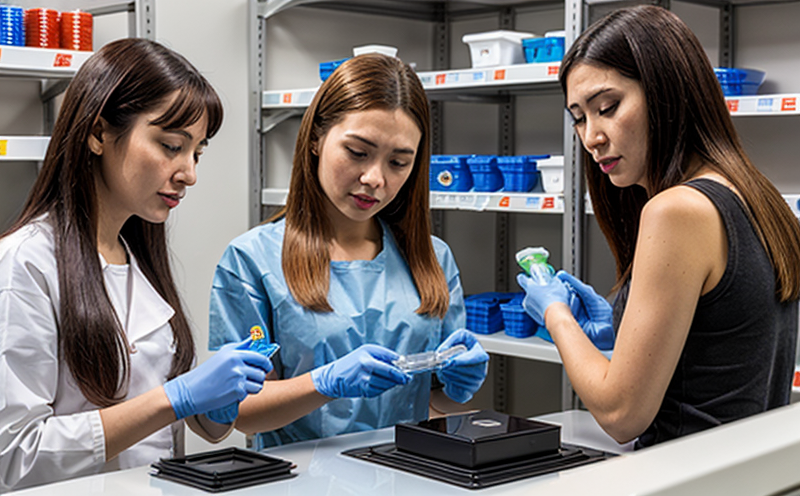JIS K 7215 Vicat Softening Temperature Testing of Consumer Plastics
The JIS K 7215 method is a standardized procedure used to determine the Vicat softening temperature (VST) of thermoplastics, which is crucial for quality assurance and compliance in the consumer plastics sector. This test evaluates the thermal stability of materials by measuring their resistance to deformation under heat, providing insights into the performance limits of the material.
The Vicat softening point indicates at what temperature a specimen deforms under a specific load applied perpendicularly. This information is vital for ensuring that products made from these polymers will withstand environmental conditions without degradation or failure during use and storage.
For consumer plastics, this test ensures product safety by preventing materials prone to excessive softening at ambient temperatures. The results help manufacturers make informed decisions regarding material selection and formulation adjustments. Compliance with JIS K 7215 is essential for meeting regulatory requirements in various countries, including Japan where the standard originated.
The testing procedure involves placing a cylindrical specimen of the plastic onto a flat steel plate. A needle is then pressed down into the sample until it penetrates to a specified depth (usually 1 mm). The temperature at which this occurs is recorded as the Vicat softening point.
This test is particularly important for consumer plastics like polyvinyl chloride (PVC), polystyrene, and certain grades of ABS. Understanding the VST allows manufacturers to optimize formulations by selecting additives or modifying base resins to achieve desired properties without compromising safety.
Compliance with JIS K 7215 also enhances brand reputation through consistent quality assurance practices. It demonstrates a commitment to high standards that can build consumer trust and loyalty. Moreover, it ensures products meet international trade requirements by aligning specifications with global norms.
The test method is widely recognized in the industry for its reliability and repeatability. Its application extends beyond just ensuring product performance; it plays a role in advancing research and development efforts aimed at creating more sustainable and efficient materials.
Given the importance of this testing, labs specializing in polymer & plastics testing must have sophisticated equipment capable of accurate measurement. This includes high-quality furnaces, precise thermal control systems, and reliable data logging capabilities to ensure consistent results across multiple tests.
Applied Standards
The JIS K 7215 Vicat Softening Temperature Testing method is specifically referenced in the Japanese Industrial Standard (JIS) document. This standard provides detailed instructions on how to perform this test correctly and accurately, ensuring that all parties involved understand what constitutes a valid result.
While JIS K 7215 focuses primarily on thermoplastics, its principles can be adapted for other types of plastic materials as well. However, modifications may be necessary depending on the specific characteristics of the material being tested.
- Type A Specimen: Used for flat specimens with a uniform thickness.
- Type B Specimen: Applied to non-flat specimens such as pipes or profiles.
The choice between Type A and Type B depends on the nature of the sample being tested. Both types follow similar procedures but take into account different geometries which affect how they respond to heat.
International Acceptance and Recognition
- Japan: JIS K 7215 is widely accepted within Japan for assessing the thermal performance of various plastic materials used in consumer products. Compliance with this standard is often required by manufacturers operating in or exporting to Japanese markets.
- Other Countries: While not as universally adopted outside Japan, there are instances where JIS K 7215 has been recognized internationally due to its rigorous nature and relevance to certain industries. Organizations like ISO may reference aspects of this standard when developing broader guidelines applicable globally.
The growing trend towards international harmonization means that standards like JIS K 7215 are increasingly being considered alongside other relevant international regulations such as ASTM D1693 for similar purposes. This collaboration helps foster better alignment between national and regional practices, making it easier for businesses to navigate global markets.
International acceptance of this standard contributes significantly to the credibility of testing results across borders. It allows companies to present their products confidently knowing that they have met stringent quality benchmarks recognized worldwide.
Competitive Advantage and Market Impact
- Better Product Quality: By adhering to JIS K 7215, manufacturers can produce higher-quality consumer plastics with improved thermal stability. This translates into longer-lasting products that maintain their integrity under varying environmental conditions.
- Enhanced Brand Reputation: Consistent compliance with recognized standards like JIS K 7215 builds trust among consumers and stakeholders. A reputation for producing reliable, safe products can differentiate a company from competitors in the marketplace.
The ability to demonstrate adherence to such stringent testing criteria provides significant competitive advantage by setting a benchmark that others strive to match or exceed. It also opens doors to new markets where regulatory compliance is critical.
In terms of market impact, successful implementation of JIS K 7215 can lead to increased sales and customer satisfaction. Consumers prefer brands they know follow strict quality control measures, leading to repeat business and positive word-of-mouth recommendations.
Moreover, companies that invest in robust testing facilities including those compliant with JIS K 7215 may find themselves ahead of competitors who do not prioritize similar investments. This strategic advantage can translate into better market positioning and greater overall profitability.





